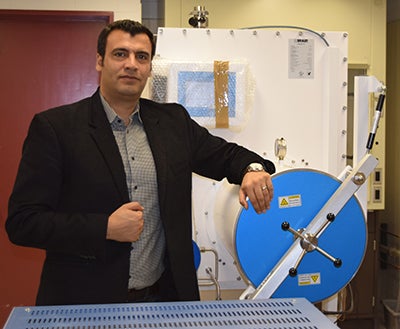Professor Reza Shahbazian-Yassar researching smart materials that can be regulated by temperature or strain
story title Heading link

Look at Chicago’s skyline and you will see giant towers of glass soaring hundreds of stories high. Imagine if all that glass could regulate the energy consumption in those buildings. From smart windows in skyscrapers to tiny molecular-scale devices that can be switched on and off at speeds of millions of a second, smart materials have high potential to revolutionize the way we live.
It may sound too good to be true, but Associate Professor Reza Shahbazian-Yassar, in the Department of Mechanical and Industrial Engineering at the University of Illinois Chicago, is leading a team that are researching the use of nanotechnology in metal-insulator transition materials that can impact the energy efficiency of buildings, development of ultrafast electronic switches, or building highly sensitive sensors.
“In my lab, we study interesting functions and properties of small-scale materials in real time,” said Shahbazian-Yassar. “We want to exploit the understanding of how these materials work and react to thermal fields, mechanical loads, electrochemical environments, and electronic fields.”
To achieve this understanding, the research team is able to simultaneously image and monitor the internal changes in very tiny materials at atomic-scale resolution.
“Often, we see the properties at that scale is totally different from what we see at bulk scale,” said Shahbazian-Yassar.
Hasti Asayesh-Ardakani, a senior Ph.D. student who works in the lab, is studying vanadium dioxide (VO2) materials that can be switched from a fully electrical insulator phase to a perfect conductor. This transition in electronic properties is accompanied by the change in optical properties.
“To give you an example of where this will be useful, think about the glass window high rises in Chicago where cooling down or heating up based on the sunlight is an issue,” said Shahbazian-Yassar. “The materials Hasti is studying are very interesting because it can be used as a coating for those windows and it regulates the amount of sunlight in based on the temperature of building interiors.
The mechanism that allows the properties to be switched is based on the change of the internal structure of that material. The researchers are examining how this change in structure happens. Asayesh-Ardakani is looking at how she can control the mechanical strain inside this material to find a way to manipulate the temperature of transition of these properties. One method she is testing is doping it with tungsten, which is bulky. In a recent publication in Nano Letters, Shahbazian-Yassar’s team demonstrated this potential through collaborations with researchers from UIC as well as investigators from Texas A&M University, University at Buffalo, and King Abdullah University of Science & Technology.
“If we understand the physics and basics of such structural transitions, then we are able make decisions,” he added. “In terms of having it working as a switch in nancomputers is still a little far.”
“Now, we can go and apply it to the application and make sure it is working the way we want it to work,” said Asayesh-Ardakani. “We want to build such devices that can work with the idea we presented.”
Research by Assistant Professor Syble Derrible, of UIC’s Department of Civil and Materials Engineering, reveals that commercial buildings in the United States are vastly over-cooled. Using data from the US Energy Information Administration and simulating data with the Department of Energy, he calculated significant energy and environmental costs, and a financial cost of $10 billion. This research is just for cooling, and doesn’t include the cost of heating.
Now, look at Chicago’s skyline and think of all major cities with skylines dominated by glass. With smart windows, energy consumption could be regulated to offer significant energy, environmental, and financial savings.
The technology Shahbazian-Yassar is researching at UIC is about more than convenience. It has the potential to offer make significant changes to our everyday life in every city around the world.
More information about Professor Shahbazian-Yassar’s research can be found at Shahbazian-Yassar.